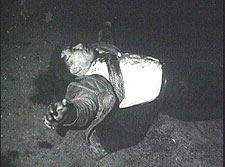On the evening of October 17, 1961 about 30,000 Algerians, ostensibly French citizens, descended upon the boulevards of central Paris to protest an 8:30 curfew, imposed by the French authorities in response to repeated terrorist attacks by Algerian nationalists in Paris and other French cities.
At that time France, led President Charles de Gaulle, was in trouble. The war in Algeria, marked by bloody atrocities committed by all sides, had been grinding on for nearly seven years. The country was constantly disrupted by strikes and protests by farmers and workers, as well as by terrorist acts by the Front de Libération Nationale (FLN - representing the Algerian nationalist independence movement), and the Organisation Armée Secrète (OAS - a group of disaffected soldiers, politicians and others committed to keeping Algeria French).
Terrorism had claimed the lives of dozens of policemen, provoking what Interior Minister Roger Frey called the "just anger" of the police. Thus, on October 17, Algerian demonstrators were met by a massive police force. Demonstrators were beaten, shot, even drowned in the Seine. Thousands were rounded up and taken to detention centers around the city, where there were more beatings and killings. Although no one seems to know for sure how many Algerians died that day, their number is estimated around 200.

DROWNING BY BULLETS exposes the massacre and the cover-up of what was undoubtedly one of the darkest nights in the history of France. Policemen, demonstrators, former officials, and journalists who witnessed the events speak on camera for the first time. These harrowing personal accounts are juxtaposed with clips from the French press, which supported the official lie that only a few people had died in the demonstration. Footage taken from state-owned French television shows how images of police brutality were replaced by those of Algerians being shipped out of France after the demonstration.
DROWNING BY BULLETS reveals a story that quickly died, suppressed by the French goverment and a complicit press, and then drowned by the events that later shocked Europe.
"Through footage, clips, photos, interviews, and eyewitnesses the directors have unraveled the spurious official accounting. By reconstructing the harrowing events as they occurred that night, the filmmakers have revealed the many lies and discrepancies of the official version; the network of complicity and intimidation that almost confined this story to the dustbin of history. More poignantly, the film portrays the shame and distress of those who, miraculously, survived this massacre, and the bewilderment of relatives who still wonder what happened to their loved ones… a must-view for students of colonialism in general and, in particular, Franco-Algerian affairs."—The French Review
"Extraordinary…This moving film provoked animated discussion among the audience and was the highlight of our [French Colonial History Society] meeting. The film illuminated for us an event, a time, and a mentality about which we had heretofore known too little."—Robert S. DuPlessis, President of the French Colonial History Society
"Extremely powerful... Compelling... could not be more timely."—Middle East Studies Association Bulletin
"A chilling documentary, especially in view of the growing influence of the extreme Right in modern France."—Daily Mail
2005 African Literature Association Film Festival
2004 African Studies Association Film Festival
2004 French Colonial History Society Conference
2003 Middle East Studies Association FilmFest
Best Documentary, 1993 San Francisco Film Festival
Best Documentary, 1993 Angers Film Festival
Fipa d'Or, 1993 Documentaires de Création (France)
1993 Amnesty International Award
